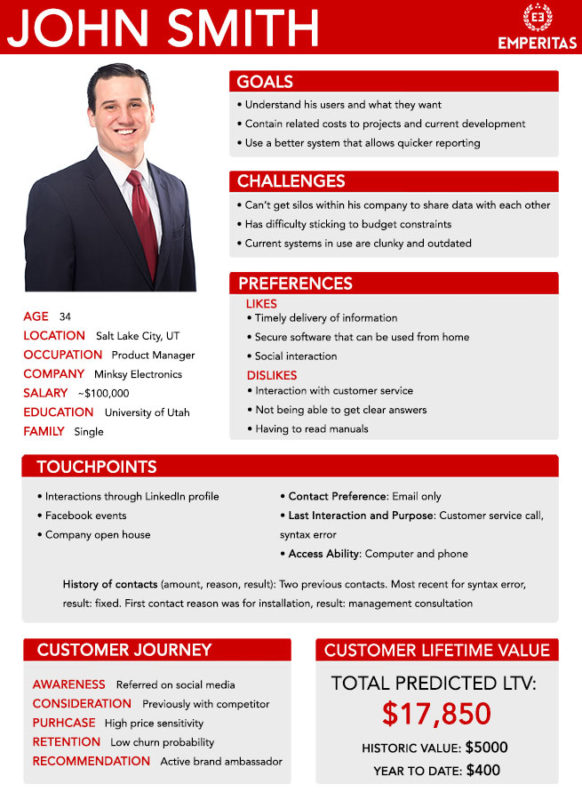Download Our Free Persona Template Here
What is a persona?
Think of a persona as a semi-fictional character who represents your ideal customer as a business. Similar to how an author introduces a character in a novel by providing background information and description, companies create personas based on market research and data gained from profiling their existing customers.
Okay, so…
Obtaining data to create personas is something that many companies do, but don’t always recognize how that data helps. However, personas can lead the direction for a large amount of content creation in a company. The point of using personas is to let a company know what content to market to whom. This way businesses can identify their most active supporters and highest value customers, driving revenue. Personas contain relevant data such as income, job title, business type, and location which are primarily used to determine what your audience has in common. A persona can be broken into multiple subcategories that individually provide meaningful information for the company.
Goals
The goals of the customer are relevant because they inform the business of what the customer wants to accomplish. Once a company knows a customer’s goals, it can determine whether or not it is capable of providing the necessary content to ensure the customer has a good experience. Understanding a customer’s goals will likely also lead to the company brainstorming for ideas to solve the customer’s dilemma. These ideas can be presented to the customer to open the discussion on what the preferred method is.
Challenges
Identifying challenges of the customer informs the company why help is needed. The company can then use their resources to attempt to resolve the problems the customer is facing. With the adoption of the new product provided, new challenges may arise, so businesses would not want to only resolve the same few challenges forever.
Preferences
Preferences are the specific likes and dislikes of the customer. Customer Preference is one of the most important concepts in marketing, especially marketing in the modern world. There are many channels now that a company can connect to a potential customer through. It’s critical to personalize marketing efforts to amplify preference for the brand. Companies need to steer customers into specific preferences early in the relationship, so the company can properly orient its services to their needs.
Touchpoints
Touchpoints explain how customer interaction can best be utilized. The last time the customer was contacted, and method of that contact are included for reference. Some customers may respond the quickest to Facebook messages, while others strongly prefer emails. The Pareto Principle in economics (known as the 80/20 principle in marketing) shows that 80% of all customer value will come from just 20% of customers. It’s important to identify who that 20% of customers are, and know those customers’ touchpoints.
Customer Journey
The “customer journey” is the pathway of a company’s relationship with the customer. Metrics that are tracked include how that customer was gained and the likelihood of that customer staying with your company for life. Answering these questions helps the company best determine the customer’s desires. For example, if a customer was recently with a competitor and switched to your business instead, you would want to ensure that you stay ahead of the competitor to make the switch appear worthwhile to your customer. Product managers would ideally utilize metrics that revolve around the customer’s journey.
Customer Lifetime Value
Arguably the most important business metric from an economic standpoint is customer lifetime value (CLV). CLV is all of the purchases a customer will make during the lifetime of their relationship with the company. A company will additionally track what the customer has spent throughout the relationship and what they have spent this year to date.



